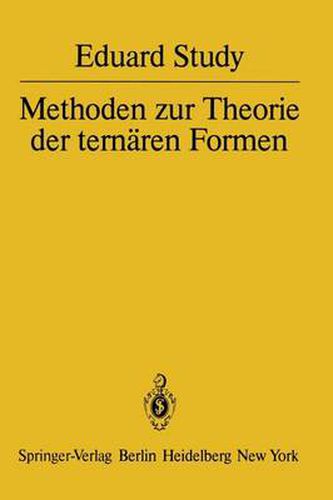Readings Newsletter
Become a Readings Member to make your shopping experience even easier.
Sign in or sign up for free!
You’re not far away from qualifying for FREE standard shipping within Australia
You’ve qualified for FREE standard shipping within Australia
The cart is loading…






This title is printed to order. This book may have been self-published. If so, we cannot guarantee the quality of the content. In the main most books will have gone through the editing process however some may not. We therefore suggest that you be aware of this before ordering this book. If in doubt check either the author or publisher’s details as we are unable to accept any returns unless they are faulty. Please contact us if you have any questions.
to E. Study’s Methoden zur Theorie der ternaren Formen Study’s Ternary Fonns presents a view of classieal invariant theory that remains little known to this day, and that deserves attentive reading. When the book was published, the combinato- rial investigations of Gordan and of the English school were in their heyday. Hilbert’s sweeping finiteness results were not yet available, and the term algebraie geometry had yet to take hold. Study’s goals were geometrie rather than algebraie. He viewed the symbolic method as an algebraic machinery for the description of geometrie properties, and his style of proof, eoneeptual to the ut- most, invariably follows a background of geometrie motivation, whieh unfortunately the author seldom reveals. Like almost everyone in his time, Study either ignored or dis- believed the work of Hermann Grassmann, to whom he pays per- funetory respeet in a couple of footnotes. The book would have benefited, especially in 19, from the notation of exterior algebra such as is common today. As it is, the author is forced to produce no less than three three-dimensional generalizations of the original Clebsch-Gordan expansion; nowadays these can be viewed as vari- ants of one straightening algorithm going baek to Capelli-Young. Study’s book breaks naturally into three parts, which can be read independently, onee one has mastered the unusual notation. As a Leitfaden, we summarize the main caveats to the reader.
$9.00 standard shipping within Australia
FREE standard shipping within Australia for orders over $100.00
Express & International shipping calculated at checkout
This title is printed to order. This book may have been self-published. If so, we cannot guarantee the quality of the content. In the main most books will have gone through the editing process however some may not. We therefore suggest that you be aware of this before ordering this book. If in doubt check either the author or publisher’s details as we are unable to accept any returns unless they are faulty. Please contact us if you have any questions.
to E. Study’s Methoden zur Theorie der ternaren Formen Study’s Ternary Fonns presents a view of classieal invariant theory that remains little known to this day, and that deserves attentive reading. When the book was published, the combinato- rial investigations of Gordan and of the English school were in their heyday. Hilbert’s sweeping finiteness results were not yet available, and the term algebraie geometry had yet to take hold. Study’s goals were geometrie rather than algebraie. He viewed the symbolic method as an algebraic machinery for the description of geometrie properties, and his style of proof, eoneeptual to the ut- most, invariably follows a background of geometrie motivation, whieh unfortunately the author seldom reveals. Like almost everyone in his time, Study either ignored or dis- believed the work of Hermann Grassmann, to whom he pays per- funetory respeet in a couple of footnotes. The book would have benefited, especially in 19, from the notation of exterior algebra such as is common today. As it is, the author is forced to produce no less than three three-dimensional generalizations of the original Clebsch-Gordan expansion; nowadays these can be viewed as vari- ants of one straightening algorithm going baek to Capelli-Young. Study’s book breaks naturally into three parts, which can be read independently, onee one has mastered the unusual notation. As a Leitfaden, we summarize the main caveats to the reader.